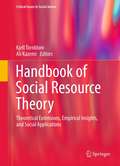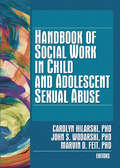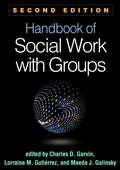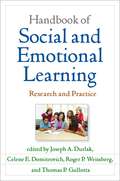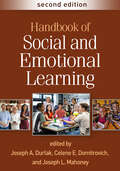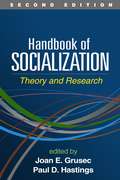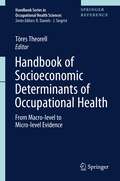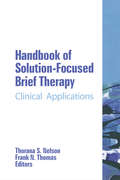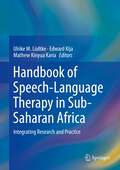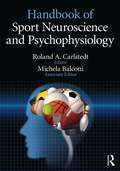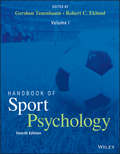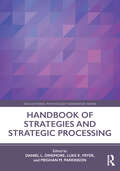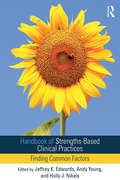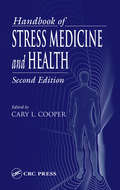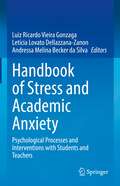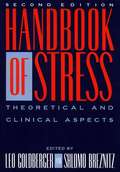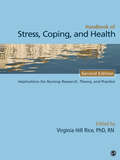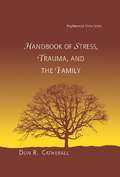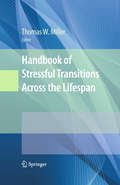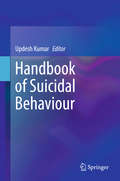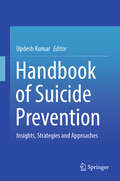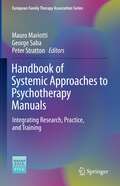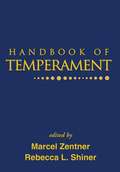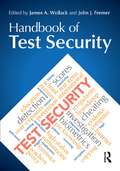- Table View
- List View
Handbook of Social Resource Theory
by Kjell Törnblom Ali KazemiA "social resource" refers to anything that is transacted between two people. It encompasses both the tangible (such as money and material goods) and the intangible (such as love, respect, information, or services) that are provided or withheld in people's daily lives. The exchange and availability of social resources have a wide range of impacts on everything from health, to quality of life, to social status, to motivation. Understanding Social Resource Theory (SRT) is a key to both Social Psychology (both sociological and psychological), and Public Policy. The framework for the study of SRT is relatively new, beginning with an article by Uriel G. Foa in 1971. Since then, this framework has developed to include new types of social resources and new applications. The Editors of this volume have worked directly with Dr. Foa before his passing, and this volume represents a continuation and development of SRT framework to new applications, including: -Quality of Life -Work Satisfaction -Interpersonal Relationships -Cognitive Development -Consumer Behavior -Cross-Cultural Behavior Contributions to Handbook of Social Resource Theory also integrate SRT with other prevailing Sociological frameworks, including: distributive and procedural justice, social comparison theory, and development of social relationships. SRT has already established a link between social psychology and economics, and this link is explored even further. With clear applications to many fields of study, including Sociology, Social Psychology, Public Policy, and Quality of Life research, this interdisciplinary volume is a clear, systematic, and comprehensive approach to understanding Social Resource Theory, its range of applications, and the future directions of research.
Handbook of Social Work in Child and Adolescent Sexual Abuse
by John S. Wodarski Marvin D. Feit Carolyn HilarskiThe enlightening collection of new approaches to understanding sexual abuseWhen sexual abuse occurs, helping those directly affected can be a difficult and convoluted task. The Handbook of Social Work in Child & Adolescent Sexual Abuse is a comprehensive guide that provides the latest information on assessment, management, prevention, and policy. Through insightful and accessible discussions, this collection of essays encompasses the full spectrum of child and adolescent sexual abuse to shed needed light on an affecting issue. This innovative text is the up-to-date source for unique and compassionate ways of supporting and treating survivors.The increased attention given to child sexual abuse in recent years has revealed how little we know about this tragedy. The Handbook of Social Work in Child & Adolescent Sexual Abuse is the practical compendium that covers the already existing information regarding violence against children and delves into practical methods for treating those immediately affected by it. From its historical place in society to contemporary issues of prevention that have only recently come to light, contributors examine essential details in-depth and provide concise, empirical directions for short- and long-term support. Also included is the important and newly-available assessment and treatment information focusing on ethnicity, gender, and comorbid influences as they relate to family member treatment.Among the topics discussed in the Handbook of Social Work in Child & Adolescent Sexual Abuse are: historical views of and responses to sexual abuse risk and protective factors life stage consequences theories of family dysfunction comorbidity and attachment intrafamilial abuse the non-family offender current empirical assessment methods approaches to treatment in children approaches to treatment in adolescents neurological effects of abuse treatment for the non-offending caregiver the role of the internet and other media policy and practice implications the prevalence and consequences of abuse new methods of abuse prevention and child protection the etiology of sexual offending in an attachment framework and much more!The Handbook of Social Work in Child & Adolescent Sexual Abuse is an essential resource for educators, medical practitioners, psychologists, psychiatrists, social workers, counselors, family therapists, and students, researchers, and academics in the field of social work.
Handbook of Social Work with Groups, Second Edition
by Charles D. Garvin Maeda J. Galinsky Lorraine M. GutiérrezThis definitive text, now revised and expanded, has introduced thousands of students and practitioners to the theory and practice of social work with groups. Leading authorities outline major models of group work and address critical issues in planning, implementing, and evaluating interventions. The Handbook describes applications in all the major practice settings--mental health, prevention, child welfare, substance abuse, health care, aging, corrections, and more--as well as organizational and community settings. A strong focus on empowerment, social justice, and diversity is woven throughout. The empirical foundations of group work are reviewed, and innovative research methods discussed. New to This Edition: *Incorporates over a decade of advances in the field *Heightened focus on practitioner-researcher collaboration. *Two chapters on substance abuse prevention with youth. *Chapters on social justice work, evidence-based practice, offender reentry, intimate partner violence, intergroup dialogue, working with immigrants and refugees, qualitative methods, and intervention research. *Major updates on existing topics, such as cognitive-behavioral group work, psychoeducational groups, health care settings, and technology-mediated groups. *Integrative epilogue that synthesizes key themes.
Handbook of Social and Emotional Learning
by Daniel Goleman James P. Comer Thomas P. Gullotta Linda Darling-Hammond Celene E. Domitrovich Roger P. Weissberg Timothy P. Shriver Jennifer Buffett Joseph A. DurlakThe burgeoning multidisciplinary field of social and emotional learning (SEL) now has a comprehensive and definitive handbook covering all aspects of research, practice, and policy. The prominent editors and contributors describe state-of-the-art intervention and prevention programs designed to build students' skills for managing emotions, showing concern for others, making responsible decisions, and forming positive relationships. Conceptual and scientific underpinnings of SEL are explored and its relationship to children's and adolescents' academic success and mental health examined. Issues in implementing and assessing SEL programs in diverse educational settings are analyzed in depth, including the roles of school- and district-level leadership, teacher training, and school-family partnerships.
Handbook of Social and Emotional Learning
by The Weissberg ScholarsThe definitive work on social and emotional learning (SEL) research and practice is now in an extensively revised second edition, featuring all-new and thoroughly updated chapters. The world&’s leading SEL scholars describe state-of-the-art interventions that build students' competencies for managing emotions, showing empathy for others, forming supportive relationships, and making responsible decisions. The scientific underpinnings of SEL are explored and its impact on academic achievement and behavior is examined. The Handbook discusses ways to assess SEL and design effective, developmentally and culturally informed programs for students in preschool through secondary school settings and beyond. New to This Edition *Reflects a decade of significant advances in research, policy, and implementation. *New and expanded topics--equity, culturally responsive practice, multi-tiered systems of support, adult SEL, technology tools and applications, mental health, scaling up successful interventions, and more. *Six chapters on international SEL efforts, discussing both developed and developing countries. *Every chapter concludes with Key Takeaway Points.
Handbook of Socialization, Second Edition
by Joan E. Grusec Paul D. HastingsThis highly regarded handbook remains the leading reference and advanced text on socialization. Bringing together foremost authorities, the volume reviews the breadth of current knowledge on socialization processes across the lifespan. Contributors present cutting-edge theories and findings pertaining to family, peer, school, community, media, and other influences on individual development. Genetics and biology, cultural psychology, and affective science are given particular attention. Three themes guide the book: the interdependence of biology and experience, the bidirectionality of socialization processes, and the many contributing factors that interact to produce multiple socialization processes and pathways. New to This Edition *Revised structure reflects the diversity of socializing relationships in multiple contexts across the lifespan. *Chapters on adolescence, socialization in the workplace, moral development, culture, and neuroscience. *Many new authors and extensively revised chapters.
Handbook of Socioeconomic Determinants of Occupational Health: From Macro-level to Micro-level Evidence (Handbook Series in Occupational Health Sciences)
by Töres TheorellThis anthology provides readers of scientific literature on socioeconomic factors and working conditions with the newest knowledge in this field. Since our world is subjected to constant change in accelerating speed, scientific reviews and updates are needed. Fortunately, research methodology in epidemiology, physiology, psychology and sociology is also developing rapidly and therefore the scientific community can provide politicians and policy makers with increasingly sophisticated and exact descriptions of societal factors in relation to work. The anthology starts in the macro level sphere – with international perspectives and reviews related to working conditions in relation to political change (the fall of the Soviet Union) gender, age, precarious employment, national economy and retirement. Two chapters relate to national policies and activities in international organizations. The second part of the book relates to the meso level sphere – with reviews on social patterns in distributions of psychosocial and physical risks at work in general as well as reviews on noise, shift work, under/overemployment, occupational physical activity, job intensity (which may be a particularly important problem in low income countries), digitization in modern work, climate change, childhood determinants of occupational health in adult years and theoretical models currently used in occupational epidemiology - demand/control, effort/reward, organizational justice, psychosocial safety climate, conflicts, bullying/harassment. This part of the book ends with two chapters on interventions (one chapter on the use of cultural interventions and one on interventions and their evaluation in general) and two chapters on financial aspects of poor/good work environments and evaluations of interventions. In the third part of the book the micro level is addressed. Here mechanisms translating working conditions into physiology are discussed. This starts in general theory relating basic theories regarding energy storage and release to psychosocial theory (extension of demand control theory). It also includes regeneration physiology, autonomic nervous system function, immunology and adverse behaviour.Sections in the Handbook: Macro-level determinants of occupational health: Akizumi Tsutsumi, Meso-level determinants of occupational health: Morten Wahrendorf and Jian Li, Micro-level determinants of occupational health: Bradley J. Wright
Handbook of Solution-Focused Brief Therapy: Clinical Applications
by Frank N. Thomas Thorana S. NelsonAn invaluable guide to the history, descriptions of practice strategies, and applications of SFBT The Handbook of Solution-Focused Brief Therapy is a unique, comprehensive guide that assists clinicians, regardless of experience level, in learning and applying the concepts of Solution-Focused Brief Therapy (SFBT) to particular situations with clients. Noted experts discuss the therapy practices and various uses for the approach in detail, which focuses on encouraging clients to look at exceptions, times when the problem could have occurred and did not, and goals and future possibilities. A history of the practice model and its interventions is discussed, along with limitations, descriptions of practice strategies, applications to specific client populations, and clinical problems and concerns. This useful resource also includes an illustrative case study that uses the SFBT model. The Handbook of Solution-Focused Brief Therapy first lays a foundation of knowledge, providing chapters on the crucial assumptions and practices, history, and epistemology behind the approach. Further chapters use that basis to explain the application of the approach with several clinical issues and various populations, including couples, depression, domestic violence, schools, children, pastoral work, therapist burnout, and a few "outside therapy room" applications. Other chapters focus on the important issues in therapist training and supervision. Extensive references are provided at the end of each chapter. Topics discussed in the Handbook of Solution-Focused Brief Therapy include: assumptions within the SFBT tradition history of the SFBT approach epistemology SFBT with couples depression domestic violence offenders public schools children and young people SFBT in faith-based communities assessing and relieving burnout in mental health practice SFBT beyond the therapy room supervision of training possible limitations, misunderstandings, and misuses of SFBT a tribute to the late Steven de Shazer, co-founder of the SFBT approach The Handbook of Solution-Focused Brief Therapy is an invaluable reference for all types of therapists, including psychologists, counselors, social workers, and family therapists at any level of experience, including students, trainees, and experienced therapists.
Handbook of Speech-Language Therapy in Sub-Saharan Africa: Integrating Research and Practice
by Ulrike M. Lüdtke Edward Kija Mathew Kinyua KariaThis book synthesizes research on language development and communication disability in Sub-Saharan Africa and highlights best practices for providing speech and language therapy services to individuals with language, communication, and hearing disorders across the lifespan. The book brings together a wide range of international contributions from various disciplines, such as speech-language pathology, audiology, developmental psychology, language education, social work, neurology, neuropsychology, pediatrics, linguistics, pedagogy, and phonetics to provide perspectives on problems, challenges, ideas, concepts, and models to serve the people in Sub-Saharan Africa. Key areas of coverage include:Challenges for speech-language therapists in the health sector.Community awareness and the sustainable delivery of services.Culture-specific support of communication and language development in early childhood.Malnutrition, dysphagia, feeding difficulties, pediatric HIV, and related issues.Communication disability treatments, including assessment and intervention, augmentative and alternative communication (AAC), and issues specific to bilingualism and biliteracy.Inclusive education of children with communication disorders with case studies from Rwanda, Tanzania, Kenya, and South Africa. The Handbook of Speech-Language Therapy in Sub-Saharan Africa is an essential reference for researchers, professors, and graduate students as well as clinicians, therapists, and other professionals in developmental psychology, speech-language pathology and therapy, social work, neuropsychology, pediatrics, special education, community based rehabilitation, and all related disciplines.
Handbook of Sport Neuroscience and Psychophysiology
by Roland CarlstedtOut of the broad arena of sport science and sport psychology, Roland A. Carlstedt presents a comprehensive collection on the neuroscience and associated psychophysiology that underlies and drives sport performance. Featuring sections ranging from the basics and foundations (anatomy and physiology) to the applied (assessment during competition, training, and mental training), Handbook of Sport Neuroscience and Psychophysiology is the first volume to provide students, researchers, practitioners, and coaches the latest knowledge on the brain, mind-body processes, and psychophysiological responding in the context of sport performance.
Handbook of Sport Psychology
by Gershon Tenenbaum Robert C. EklundThe fourth edition of a classic, leading resource for the field of sport, exercise, and performance psychology Now expanded to two volumes, and featuring a wealth of new chapters from highly respected scholars in the field, this all-new edition of the Handbook of Sports Psychology draws on an international roster of experts and scholars in the field who have assembled state-of-the-art knowledge into this thorough, well-rounded, and accessible volume. Endorsed by the International Society of Sport Psychology, it represents an invaluable source of theoretical and practical information on our understanding of the role of psychology in sport, exercise, and performance—and how that understanding can be applied in order to improve real-world outcomes. Presented in eight parts, the Handbook of Sports Psychology, 4th Edition adds new material on emerging areas such as mindfulness, brain mapping, self-consciousness, and mental toughness, and covers special topics such as gender and cultural diversity, athletes with disabilities, and alcohol and drug use in sports. In addition, it covers classic topics such as what motivates an athlete to perform; why do some choke under pressure; how do top performers handle leadership roles; what does one do to mentally train; how an athlete deals with injury; and much more. Fourth edition of the most influential reference work for the field of sport psychology New coverage includes mindfulness in sport and exercise psychology, ethics, mental toughness, sport socialization, and making use of brain technologies in practice Endorsed by the International Society of Sport Psychology (ISSP) Handbook of Sports Psychology, 4th Edition is an indispensable resource for any student or professional interested in the field of sports psychology.
Handbook of Strategies and Strategic Processing (Educational Psychology Handbook)
by Daniel L. Dinsmore Luke K. Fryer Meghan M. ParkinsonHandbook of Strategies and Strategic Processing provides a state-of-the-art synthesis of conceptual, measurement, and analytical issues regarding learning strategies and strategic processing. Contributions by educational psychology experts present the clearest-yet definition of this essential and quickly evolving component of numerous theoretical frameworks that operate across academic domains. This volume addresses the most current research and theory on the nature of strategies and performance, mechanisms for unearthing individuals’ strategic behaviors, and both long-established and emerging techniques for data analysis and interpretation.
Handbook of Strategies and Strategic Processing (Educational Psychology Handbook)
by Daniel L. Dinsmore Luke K. Fryer Meghan M. ParkinsonHandbook of Strategies and Strategic Processing provides a state-of-the-art synthesis of conceptual, measurement, and analytical issues regarding learning strategies and strategic processing. Contributions by educational psychology experts present the clearest-yet definition of this essential and quickly evolving component of numerous theoretical frameworks that operate across academic domains. This volume addresses the most current research and theory on the nature of strategies and performance, mechanisms for unearthing individuals’ strategic behaviors, and both long-established and emerging techniques for data analysis and interpretation.
Handbook of Strengths-Based Clinical Practices: Finding Common Factors
by Andy Young Jeffrey K. Edwards Holly J. NikelsAn interdisciplinary handbook about strengths-based clinical practices, this book finds the common factors in specific models from social work, psychology, and counseling. The book ends with a grounded theory informed method that pulls together what each of the chapters report, and posits a theory based on that work. Comprised of 23 chapters and written by leaders in the human services fields, Handbook of Strengths-Based Clinical Practices shows how professionals and students can facilitate change and resiliency in those with whom they work.
Handbook of Stress Medicine and Health
by Athel Cornish-BowdenResearch now shows us that long-term activation of the stress cycle can have a hazardous, even lethal, effect on the body, increasing the risk of obesity, heart disease, depression, cancer, and other illnesses. This new edition of an award-winning book presents cutting-edge research on the effects of stress.Edited by one of the worlds authorit
Handbook of Stress and Academic Anxiety: Psychological Processes and Interventions with Students and Teachers
by Luiz Ricardo Vieira Gonzaga Letícia Lovato Dellazzana-Zanon Andressa Melina Becker da SilvaThis handbook presents an overview of research on test anxiety and related forms of students’ stress and anxiety at schools and other academic environments, and also brings together a series of psychological interventions to prevent and treat anxiety disorders related to academic assessments. Its aim is to inform about strategies that help promote more adaptive behaviors towards academic assessment, as well as discuss other variables (e.g., bullying) that influence test anxiety, a typical stressor at the school and academic environment. These stressors can impair the students’ socio-cognitive development, impairing their ability to study and posing a risk to their mental health. The volume is organized in three parts. The first part brings together chapters discussing different variables and processes associated with academic anxiety, such as test anxiety and social influence, academic motivation, bullying, and procrastination. The second part is completely dedicated to psychological interventions with students designed to promote adaptive coping strategies to deal with academic anxiety and to prevent the development of psychopathologies associated with it. These interventions are based on different approaches, such as cognitive behavioral therapy, acceptance and commitment therapy, analytic behavioral therapy, dialectical behavioral therapy, and mindfulness, among others. Finally, the third part presents strategies that teachers can adopt to manage academic anxiety. The Handbook of Stress and Academic Anxiety: Psychological Processes and Interventions with Students and Teachers will be a valuable resource for school and clinical psychologists, teachers, school managers and policy makers by providing information based on the best scientific evidences to help students cope with academic anxiety, prevent the development of psychopathologies associated with it and promote mental health at schools and other academic environments.
Handbook of Stress, 2nd Ed
by Leo Goldberger Shlomo Breznitz40 essays by specialists examine a variety of stress-related conditions. They cover the clinical, research and theoretical aspects of stress - the concept of stress, biological/psychological phenomena, treatment and support. New to this edition are chapters on AIDS, the burnout phenomenon, ageing, chronic illness, the aftermath of the Holocaust, psychosomatic disorders, biomedical indices of stress and sexual abuse. The chapters on personality, emotion, cognitive processes, depression, bereavement, work-stress, disaster, trauma, alcoholism, stress management and social suppport have been significantly revised.
Handbook of Stress, Coping, and Health: Implications for Nursing Research, Theory, and Practice (2nd Edition)
by Virginia H. RiceThis unique and comprehensive handbook examines the various models of stress, coping, and health and their relevance for nursing and related health fields. Building on the first edition that has been highly-praised for its analysis and critique of existing models and its discussion of new research surrounding self-regulation and stress, this Second Edition continues to provide a critical analysis of the field while providing up to date cutting-edge research. Under the expert editorship of Dr. Virginia Hill Rice, experienced scholars and practitioners present a broad range of issues and research that relate to stress and health, such as response-oriented stress; stimulus-oriented stress; and transactional stress, coping, and health in children, adolescents, attitudes, and much, much more.
Handbook of Stress, Trauma, and the Family (Psychosocial Stress Series)
by Don R. CatherallThe Handbook of Stress, Trauma, and the Family is broken down into three sections, compiling research, theory and practice. The first section focuses on how traumatic stress affects intimate others, what familial characteristics affect individual susceptibility to trauma, as well as evaluation of the effectiveness of various interventions. The section on theory explores concepts of stress and intrapsychic processes underlying the intergenerational transmission of trauma, addressesing how families can buffer or enhance anxiety. The final section, entitled practice, covers assessment (presenting both the Circumplex Model and Bowenian family theory models), treatment models and treatment formats for specific populations. The major family treatment models applicable to stress and trauma are discussed, including contextual, object relations, emotionally focused and critical interaction therapy.
Handbook of Stressful Transitions Across the Lifespan
by Thomas W. MillerThe modern life cycle is characterized by stressful transitions, when unexpected events--and even many expected ones--challenge people's functioning, health, and sense of self-worth. The international, multidisciplinary perspectives provided in the Handbook of Stressful Transitions Across the Lifespan cover these periods as they occur through youth, adulthood, and aging, bringing together theoretical and clinical findings, case studies, and literature reviews in one authoritative volume. A diverse panel of clinicians, researchers, and educators focuses on the psychological, biological, cultural and spiritual factors surrounding not only trauma and loss but also coping and growth, risk and mitigating factors, and promising interventions. Whether topics are just beginning to receive in-depth attention (the first job; becoming adoptive parents), ongoing issues requiring new insights (veterans' adjustment to civilian life; chronic illness), or emerging concepts (trauma growth; animal-assisted therapy), coverage is well-written, engaging, and eminently useful. A sampling of the topics featured in the Handbook: The developmental neurobiology of stress. The long-term effects of divorce on children. Self-regulation across life transitions. Money in (E)motion: stressful financial transitions. The influence of food on adapting to life stressors. The transition to retirement as a stressful event. With its comprehensive scope and wealth of data, the Handbook of Stressful Transitions Across the Lifespan will appeal to a variety of professional readers, including researchers and scholars in the fields of social, developmental and clinical psychology, sociology, and public health.
Handbook of Suicidal Behaviour
by Updesh KumarThis essential reference volume in the field of suicidology brings forth leading-edge conceptualizations of suicidal behaviour by including emerging trends and recent research advances in the field across the globe. It highlights the trajectories of suicidal behaviour, emphasizing the psyche behind attempting suicide, identifying vulnerable groups, and bridging the gap between theoretical underpinnings and application for addressing the aftermath of suicide. The handbook delineates research progress on risk assessment among vulnerable groups of varied milieu. Furthermore, it introduces various avenues of change and well-being. It also addresses important concerns related to terrorism and suicide in the armed forces. This handbook is a comprehensive repository of the latest research synergized with theoretical conceptualizations that pave the way for newer approaches towards management and prevention of suicidal behaviour. It includes contributions by eminent authors across the globe, and is a must-have resource for scholars, academics and professionals in the areas of mental health and social work.
Handbook of Suicide Prevention: Insights, Strategies and Approaches
by Updesh KumarThe Handbook of Suicide Prevention covers a broad range of topics related to suicidal behaviour, including its underlying causes, risk factors, prevention strategies, and therapeutic approaches. With contributions by renowned experts in the field, the volume brings forth the latest research and clinical insights into suicidal behaviour. It highlights evidence-based practices effective in reducing suicide risk. It provides a comprehensive overview of the multidimensional perspectives, including biological, psychological, and social factors contributing to suicidal ideation and behaviour. The book provides a nuanced and extensive understanding of how suicide risk and protective factors are shaped by social, cultural, and political contexts across the lifespan. The last section of the volume highlights the need for a multifaceted approach to suicide prevention by leveraging the latest technologies and therapeutic modalities while also addressing the social and cultural factors that contribute to suicide risk. Suicidal behaviour remains an intriguing phenomenon that demands addressing being among the leading causes of death worldwide. The handbook is a compilation of essential resources that offers a multitude of theoretical and compassionate approaches to understanding and addressing this complex phenomenon. Its practical guidance and evidence-based recommendations make it an essential reference for anyone working in suicide prevention, mental health and social work.
Handbook of Systemic Approaches to Psychotherapy Manuals: Integrating Research, Practice, and Training (European Family Therapy Association Series)
by Peter Stratton George Saba Mauro MariottiThis handbook examines the development and use of manuals to guide and support systemic couples and family therapies. It addresses the process of manualizing, providing a secure base for therapist creativity rather than delineating prescriptive procedures. The volume addresses therapist and trainer concerns by demonstrating the value of sufficiently articulating clinical and teaching models to inform colleagues of what actually occurs during therapy. The book describes the history, value, and controversies of manuals. In addition, it explores issues and experiences in the creation of manuals, identifies research issues related to the use and evaluation of manuals, and addresses training as a context for the application of treatment manuals.Key areas of coverage include:Reports of experiences with major, internationally established manuals, formulations of innovative practices by their developers, and specifications of training programs.Discussion of the various formats of manuals, demonstrating their benefit and transportability across different contexts.Surveys of a broad selection of manuals, creating a flexible and diversified concept of what forms manuals may take.Essential guidance for using manuals, which is an indispensable step for the field to progress and to claim to health resource commissioning, governments and insurance agencies that the systemic practice is evidence based and effective.The Handbook of Systemic Approaches to Psychotherapy Manuals is an essential resource for researchers, professors, and graduate students as well as clinicians and related therapists and professionals in clinical psychology, family studies, public health, social work, psychotherapy, child and adolescent psychology and all interrelated disciplines.
Handbook of Temperament
by Rebecca L. Shiner Marcel ZentnerTimely and authoritative, this unique handbook explores the breadth of current knowledge on temperament, from foundational theory and research to clinical applications. Leaders in the field examine basic temperament traits, assessment methods, and what brain imaging and molecular genetics reveal about temperament's biological underpinnings. The book considers the pivotal role of temperament in parent-child interactions, attachment, peer relationships, and the development of adolescent and adult personality and psychopathology. Innovative psychological and educational interventions that take temperament into account are reviewed. Integrative in scope, the volume features extensive cross-referencing among chapters and a forward-looking summary chapter.
Handbook of Test Security
by James A. Wollack John J. FremerHigh stakes tests are the gatekeepers to many educational and professional goals. As such, the incentive to cheat is high. This Handbook is the first to offer insights from experts within the testing community, psychometricians, and policymakers to identify and develop best practice guidelines for the design of test security systems for a variety of testing genres. Until now this information was scattered and often resided inside testing companies. As a result, rather than being able to learn from each other’s experiences, each testing entity was left to re-create their own test security wheel. As a whole the book provides invaluable insight into the prevalence of cheating and “best practices” for designing security plans, training personnel, and detecting and investigating misconduct, to help develop more secure testing systems and reduce the likelihood of future security breaches. Actual case studies from a variety of settings bring to life how security systems really work. Examples from both domestic and international programs are provided. Highlights of coverage include:• Best practices for designing secure tests• Analysis of security vulnerabilities for all genres of testing• Practical cheating prevention and detection strategies• Lessons learned in actual security violations in high profile testing programs. Part I focuses on how tests are delivered for paper-and-pencil, technology-based, and classroom testing and writing assessment. Each chapter addresses the prevalence of the problem and threats to security, prevention, and detection. Part II addresses issues essential to maintaining a secure testing program such as planning and monitoring, physical security, the detection of group-based cheating, investigating misconduct, and communicating about security-related issues. Part III examines actual examples of cheating-- how the cheating was done, how it was detected, and the lessons learned. Part III provides insight into security issues within each of the Association of Test Publishers’ four divisions: certification/licensure, clinical, educational, and industrial/organizational testing. Part III’s conclusion revisits the issues addressed in the case studies and identifies common themes. Intended for organizations, professionals, educators, policy makers, researchers, and advanced students that design, develop, or use high stakes tests, this book is also ideal for graduate level courses on test development, educational measurement, or educational policy.
